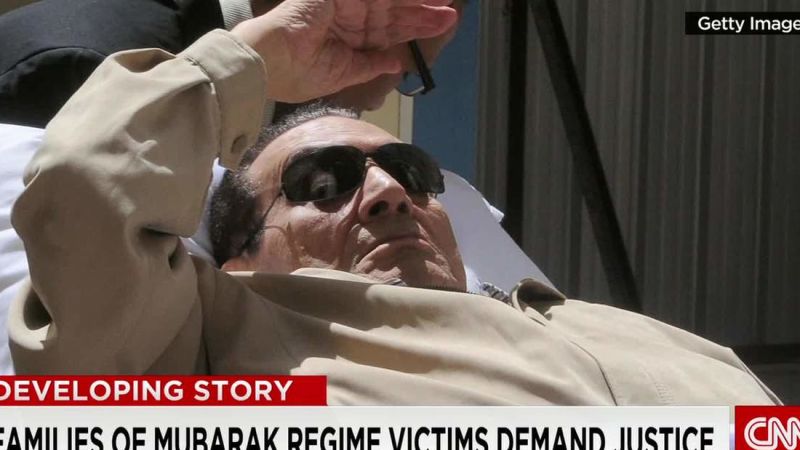Story highlights
Six years ago, the rule of President Hosni Mubarak came to a quick end
During Mubarak’s trial, the judge called him an “accessory to murder”
CNN
—
There were two constants in Egypt on January 24, 2011; the flow of the Nile and President Hosni Mubarak would die in office. The 30-year rule of Egypt’s “Modern Pharaoh” appeared to be secure, shored up by the feared State Security. Any anti-government protests were corralled into pens surrounded by riot police outnumbering protesters 10 to one.
Egypt wasn’t immune to regional events. The momentum leading up to the country’s uprising started in Tunisia. Egyptians watched closely how protesters ousted President Zine El Abidine Ben Ali. Local activists selected January 25 for the protests to coincide with National Police Day.
That morning, demonstrators gathered across the city and descended on Tahrir Square. I found myself next to the High Court, one of the usual gathering points. Dozens of protesters were in their pen surrounded by riot police. It seemed like a typical day of lackluster protesting. I decided to see if protesters were bigger in other parts of the city when, like an apparition, hundreds of angry, chanting Egyptians appeared behind the police.
Outflanked, the riot police scrambled to reorganize. But the wave of protesters smashed through their lines. Time after time, the police scrambled but couldn’t reorganize. The protesters breached Tahrir. The police pulled back.
That night the police used extreme force to clear the square. Protesters were tear gassed, kicked, and beaten with clubs.
News of the protests spread across the country. Suez, a historically resistive city, took the first steps toward revolution. Protesters surrounded and attacked the police headquarters.
Mubarak initially responded with violence. Hundreds of Egyptians around the country died in clashes with police. When that didn’t work, the President tried concessions.
Mubarak delegated powers to a vice president, Omar Suleiman, and vowed not to run for re-election. Too little too late. Enraged protesters remained in the square. We last saw Hosni Mubarak as a free man on February 10, 2011, during a TV address. The following day, Suleiman announced Mubarak’s resignation. The square erupted into a large party. People I spoke with that night were full of energy and optimism.
Mubarak fled to his seaside home in Sharm El Sheikh. Authorities finally apprehended him in April after increasing public pressure.
Egyptians were glued to their TVs on the day of the trial. The world’s press had gathered outside the police academy, ironically, previously named after Mubarak. Protesters outnumbered the former President’s supporters. Riot police struggled to keep the two sides separated. The courtroom’s events unfolded on large screens erected outside the academy.
A hush came over the country when the 83-year-old entered the courtroom. Two-thirds of Egyptians never knew another president. For many, he was a father figure. Mubarak appeared in a hospital bed wearing white prison garb, sunglasses, and a scowl. The once strongman looked frail and bitter.
Local press called the next 10 months the “Trial of the Century.” It became a source of intrigue, rumor and speculation. The day of the final verdict, Egypt was on edge. Anything less than what protesters viewed as an appropriate sentence would send them back into the streets.
In the cacophony of the courtroom, the judge called the former President an “accessory to murder” and sentenced him to life in prison.
Jubilation erupted outside the academy and on the streets of Cairo. It wouldn’t last long. Egypt wouldn’t escape political and economic turmoil in the years to follow. The first democratically elected president would be deposed in a popular military coup. Tourism was reduced to a trickle and the economy was on the brink of collapse.
An ISIS insurgency took hold in northern Sinai where hundreds of police officers, civilians and soldiers would be killed in the daily battles.
Meanwhile, appeals grew more favorable for the former dictator until finally a judge dismissed the case. Another judge would fine Mubarak for corruption and order his release for time served.
People outside Egypt might have expected anger in the streets. But six years of rising unemployment, inflation, and repression took the wind out of the sails. Many Egyptians now view Mubarak’s reign through rose-tinted lenses, when stability, the economy, and tourism were stronger.
The other irony of this story is the fate of thousands of Egyptians, including many activists, who took the streets back in 2011. They now wallow away in prison while Mubarak walks free.
Sumber: www.cnn.com





